Effective Techniques for Removing Wine Stains
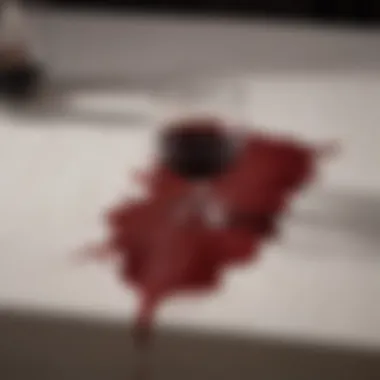
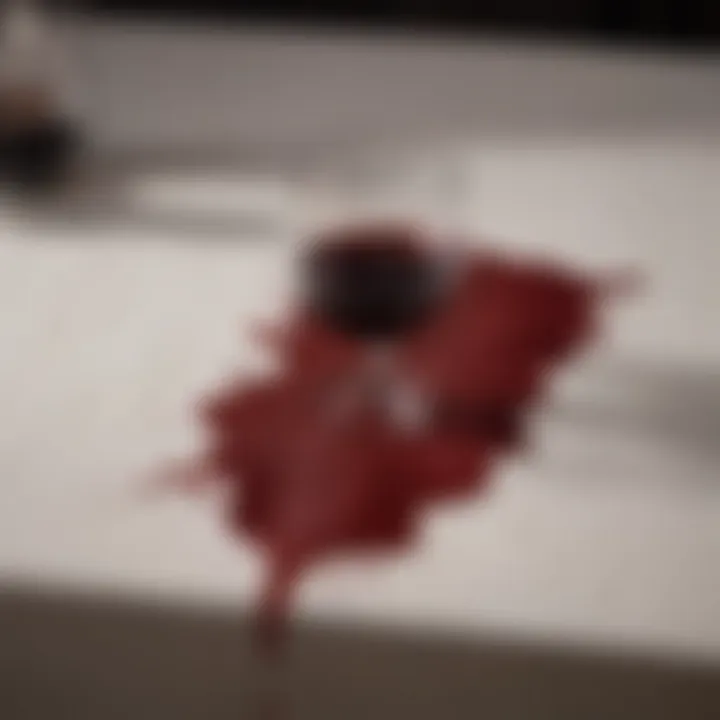
Intro
Wine stains can be like that uninvited guest at a party—unexpected and hard to deal with. Whether it's a lively gathering with friends or a quiet dinner, someone spills a glass of red wine, and suddenly you’re faced with a daunting task of removing that deep maroon blotch. The good news is that effective approaches exist, and they can save your favorite tablecloth or upholstery from becoming a casualty.
In this guide, we sift through the most reliable methods and preventive measures to approach wine stains efficiently. It's not just about reaction; it's about being prepared. You’ll learn how to tackle various surfaces—be it carpet, fabric, or hardwood—while equipping yourself with tools and tips to keep your space looking pristine.
So, if you're tired of fretting over every glass of celebrated Merlot or any new vintage poured in your home, dive in and arm yourself with the knowledge to combat those pesky stains with grace.
Understanding Wine Stains
Wine stains are more than just blemishes on your favorite tablecloth or carpet; they pose a unique challenge for homeowners and hosts alike. Knowing how to address them effectively can save time, money, and frustration. In this section, we delve into the various types of wine stains and the chemistry behind them, laying the groundwork for effective stain removal techniques.
Types of Wine Stains
Understanding the type of stain is crucial. Not all wine stains are created equal, and recognizing their distinct characteristics informs the best approach to tackle them.
Red Wine Stains
Red wine stains are notorious for their deep, rich color that can seem almost permanent. The dark pigments in red wine come from the grape skins and seeds, which offer a unique challenge in stain removal. One of the key traits of red wine stains is their propensity to set in quickly, especially on absorbent surfaces like fabric or carpet.
While they are undoubtedly a common predicament, red wine stains also serve as a learning opportunity for stain management. Their vivid nature is a reminder of the importance of immediate action—if you wait too long, you might as well kiss that fabric goodbye. The boldness of red wine is what makes it pleasurable to drink, but that same quality can transform a relaxing evening into a cleaning catastrophe.
White Wine Stains
On the other hand, white wine stains might seem less daunting due to their lighter color. However, they can be just as stubborn. The acidic nature of white wine, while less pigmented, can weaken the fabric fibers and lead to discoloration over time.
People often overlook white wine stains because they don’t have the dramatic visual impact of red wine. Yet, this can lead to a slower, more subtle type of damage. The advantage here is that white wine generally dries clear, making it less conspicuous at first glance. But don’t let that fool you; the damage can still be lurking beneath the surface, waiting to rear its ugly head at the worst possible moment.
Sparkling Wine Stains
Sparkling wine is a unique case in the battle against stains. The bubbles in sparkling wine can actually spread the liquid more rapidly across a surface, intensifying the chances of a stain forming. People often enjoy sparkling wines during celebratory moments; however, those same celebrations can result in a champagne catastrophe when spills occur.
Sparkling wine stains have a key characteristics: their effervescence can lead to quicker absorption into fibers and continuous bubbling can create a film that makes cleaning more difficult. Unlike red or white wine stains, you may find that sparkling stains can be lighter in color but equally troublesome to remove, depending on the specific beverage.
The Chemistry of Stains
Getting to the root of any stain problem requires a basic understanding of the chemistry involved. Here, we touch upon some scientific concepts that impact how wine stains form and behave on various surfaces.
Phenolic Compounds
Phenolic compounds are the real culprits behind wine stains. These naturally occurring substances play roles in flavoring and color in the wine. What makes them particularly relevant for our discussion is their staining ability. They are potent and can bind tightly to fabric fibers, making their removal a painstaking process.
This also means that when it comes to stain removal, the sooner you can treat a stain, the less chance there is for those compounds to bond with the material. This forms a lasting commitment. Understanding these compounds helps to inform the types of cleaning substances that can break down their bonds, which is essential for a successful cleaning endeavor.
Acidity and Staining
The acidity of wine can also play a significant role in staining. High acidity in white wine reacts differently compared to red wine, which may have lower acidity and more tannins. The acidic properties can cause certain fabrics to lose color or sheen.
Knowing about acidity can guide you on how to approach stains. For instance, while lemon juice might seem like a good cleanup solution, its acidity could further damage specific fabrics. Therefore, understanding the intrinsic qualities of acidity in wine helps in making informed choices on potential cleaning methods.
Identifying the Affected Surface
Understanding the affected surface is the first step in tackling wine stains effectively. Each material responds differently to cleaning methods, making it crucial to identify whether the stain is on fabric, upholstery, or a hard surface. Getting this right can save both time and effort, as using inappropriate methods can lead to further damage or ineffective results. Recognizing the type of material helps in choosing the most suitable removal technique. Here’s a deeper look into the surfaces that often fall prey to those wine mishaps.
Fabric and Upholstery
Natural Fabrics
Natural fabrics, such as cotton, linen, and wool, are known for their breathability and softness. These materials generally absorb stains more readily, which can make wine stains tricky to manage. A key characteristic of natural fabrics is that they are biodegradable, which is beneficial for environments seeking sustainability.
However, the drawback lies in their susceptibility to staining; once red wine seeps in, it can cling fast and may need urgent attention to avoid permanent marks. Natural fabrics require gentler treatment, as harsh chemicals might lead to fading or damage.
A further unique feature is that many natural fibers may shrink or distort when exposed to high temperatures or aggressive cleaning agents. Therefore, special care should be taken, usually suggesting cold water approaches and gentle blotting.
Synthetic Fabrics
Synthetic fabrics, such as polyester and nylon, tend to resist staining compared to their natural counterparts. This key advantage makes them a popular choice for furniture and clothing alike. Not only are they often more durable, but they also exhibit greater flexibility in cleaning options.
Yet, the very qualities that make synthetic fibers stain-resistant also complicate cleaning methods. They can sometimes be more prone to water spotting when improperly cleaned. These fabrics tend to require special attention to the right cleaning products, as certain solvents can damage the fibers. Keeping an eye on application techniques—like avoiding excessive scrubbing—is vastly important.
Hard Surfaces
Wood
Wooden surfaces are often the pride of a home, but wine stains can be a real threat. Wood is porous and may absorb liquids, resulting in darker spots. A prime benefit of wood is its aesthetic warmth and timelessness. However, getting those stains out can be challenging if the liquid seeps in. Often, it may require a specific cleaning solution that both lifts stains and preserves the finish, like oils or lemon juice mixed with beeswax.
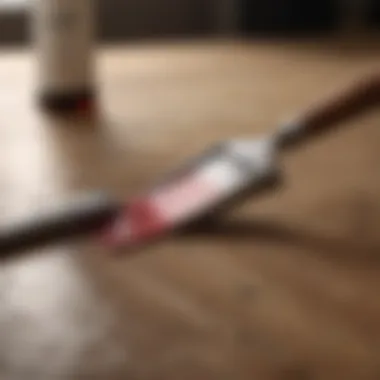
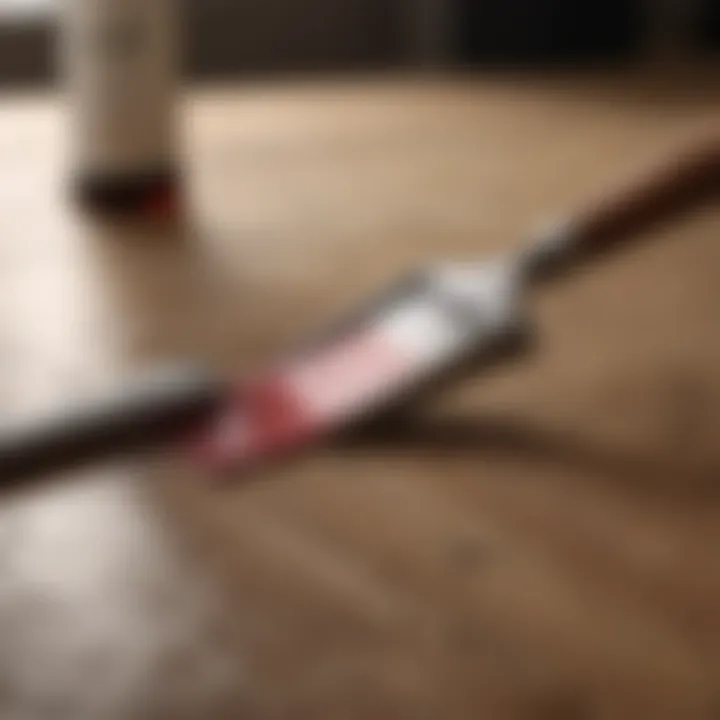
On the downside, abrasive cleaning methods can easily scratch the finish, necessitating a careful touch.
Tile
Tile surfaces, whether ceramic or porcelain, are generally more resilient against staining, but they are not stain-proof. The non-porous nature allows some resistance; however, grout lines can absorb and stain if not sealed properly. A core strength of tile is easy maintenance; most stains can be wiped away with appropriate cleaners. Despite this, older tiles might discolor without prompt care, turning a seemingly minor spill into a lasting eyesore.
Marble
Marble is a stunning choice, commonly used in kitchens and bathrooms for its beauty. Yet, it's a double-edged sword due to its sensitivity to acidic substances, including wine. Marble’s unique feature is its elegance and natural veining, yet it is very porous, making it particularly vulnerable to stains.
A major consideration with marble is using appropriate, less acidic cleaners that don’t compromise the stone's integrity. While maintenance can sometimes be a hassle, the payoff is a luxurious aesthetic if managed properly.
Identifying the affected surface helps not only in the immediate response to a stain but also aids in planning preventative measures in the future. Knowing the characteristics of the materials in your home prepares you for any unexpected wine stains.
Immediate Actions to Take
When faced with a wine stain, speed is of the essence. The steps taken right after the spill can make a world of difference in how well and how quickly you can get rid of that unsightly mark. It’s crucial to jump into action immediately, as waiting can lead to a much bigger headache down the line. Timely intervention not only helps in lightening the stain but can also prevent it from setting in permanently. The benefits of swift action are significant, especially for homeowners who value their fabrics and surfaces.
Blotting Techniques
The act of blotting is one of the first lines of defense in wine stain removal. It’s about taking a gentle approach, allowing the blotting material to soak up as much of the wine as possible without pushing the liquid deeper into the fibers of the fabric. This section dives into two effective blotting techniques: the classic paper towel method and the use of microfiber cloths.
Using Paper Towels
Paper towels are a widely recognized choice when it comes to taking on spills like wine. Their absorbent nature means they can soak up liquid quickly, and they are readily available in most homes. The key characteristic of using paper towels is that they are disposable; once they are full of wine, you can just toss them away. This makes the cleanup process pretty straightforward.
However, there's a unique feature worth noting about paper towels: they can sometimes leave behind fibers or lint. Yet, when employed properly—by using the gentlest touch and dabbing instead of scrubbing—they can effectively draw out a significant amount of the stain, providing a head start in the overall cleaning process.
Microfiber Cloths
On the other hand, microfiber cloths offer a robust option for wine stain removal. These cloths are designed to trap dirt and absorb moisture far more effectively than traditional fabrics. The key characteristic of microfiber is its finely woven structure, which allows it to lift and capture particulates without extensive pressure.
A notable advantage of using microfiber cloths is their reusability. You can wash them and use them repeatedly, making them not just eco-friendly but rather economical in the long run. However, their high-tech texture does mean that they might require a bit more effort to maintain and clean than disposable paper towels.
Avoiding Common Mistakes
In the heat of the moment, it’s easy to make what might seem like small mistakes that can have significant consequences. Understanding what NOT to do can be as important as knowing the right steps to take in wine stain removal.
Rubbing the Stain
When a spill occurs, the instinctual reaction is often to rub at the stain to get rid of it. This is a common mistake. Rubbing can push the wine deeper into the fibers, making it more entrenched in the fabric and ultimately more challenging to remove. The key takeaway here is to pat, don’t rub. By dabbing outward from the center of the stain, you can minimize the impact, allowing the cleaning solution to work more efficiently.
A flaw in this approach is that many people might think rubbing could help, but the opposite is true. It can lead to permanent damage or discoloration of the fabric long before you realize.
Using Hot Water
Another common misstep is reaching for hot water right away. Although hot water can effectively dissolve many stains, when it comes to wine, it's a bad idea. Hot water can actually cause wine stains to set in, making them much more stubborn. The reason behind this is that the heat can bind the pigments of the stain more firmly into the fibers of your fabric.
Instead, it’s better to start with cold water to halt the staining process. This cautionary principle serves as a reminder: while heat might be your friend in many cleaning scenarios, wine stains require a cooler touch to ensure an easier removal process.
Classic Cleaning Methods
When it comes to addressing wine stains, classic cleaning methods hold a treasure trove of time-tested solutions. These methods are not just relics of the past; they offer practical, often accessible strategies that many find effective. Understanding the strengths and limitations of these techniques is vital for anyone dealing with such stubborn stains regularly. They not only empower individuals to take matters into their own hands but also promote a sense of resourcefulness in tackling mishaps that occur during gatherings or quiet evenings alike.
Salt Method
Application
The salt method is a classic approach that has stood the test of time, primarily due to its simplicity and effectiveness. To apply this technique, one needs to promptly sprinkle a generous amount of salt over the fresh stain. The salt's absorbent nature works wonders.
The key characteristic of this application is its immediate action. By soaking up the liquid, salt prevents the wine from setting into the fabric. This promotes the initial steps of stain removal in an incredibly straightforward manner. On the other hand, the unique feature of this method lies in its availability; most people already have salt in their kitchens. It’s budget-friendly and easy to execute but comes with its own limitations. For instance, salt may not entirely eliminate the stain on all fabrics, especially delicate ones. However, its effectiveness in minimizing damage during the crucial first moments cannot be overstated.
Effectiveness
The effectiveness of the salt method lies in its capacity to absorb liquid before it seeps deeper into fibers. This characteristic makes it a popular choice for those needing a quick fix during parties or wine tastings.
The unique feature of this approach is its reliance on a common household item that many overlook. While it may not be a magic bullet, it often significantly lightens the stain if used promptly. One advantage is that it’s suitable for a variety of surfaces, but it risks damaging delicate or colored fabrics since salt can sometimes leave a residue. Overall, while it’s a simple trick, its effectiveness in the initial stages of stain treatment is worth appreciating.
Baking Soda Paste
Preparation
Preparation of a baking soda paste is another go-to classic method that many swear by, particularly due to the ingredient's versatility. To make this paste, one typically mixes one part water with three parts baking soda until it forms a thick consistency.
Baking soda’s key characteristic in this context is its mild alkalinity and abrasive quality. This makes it a strong contender for lifting stains without extensive scrubbing. The unique feature of this preparation technique is its ability to tackle odors as well—something wine stains often leave behind. One downside might be that it requires a bit of time for mixing and setting up, but the effort is usually justified when treating larger stains.
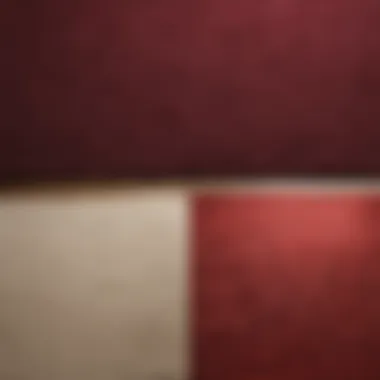
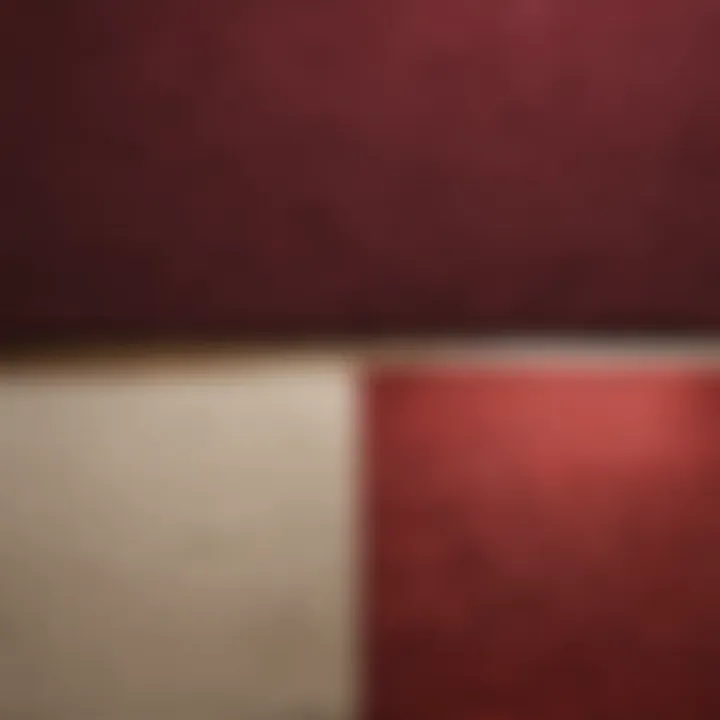
Application
When it comes to application, the baking soda paste shines as an effective stain remover. After making it, gently smear the paste onto the stain and allow it to sit for about 30 minutes or so. As it dries, it pulls the stain particles away from the surface.
The key characteristic here is that baking soda not only absorbs the wine but also helps neutralize the acidity, which can often cause lingering stains. Many find it beneficial because of this dual-action. However, the unique feature of this application method is the gentle scrubbing that can be applied afterward if needed. Some fabrics might withstand it better than others, so this could pose a disadvantage for very delicate materials. Nevertheless, it serves as an excellent choice for a broad range of scenarios, providing an effective and economical solution.
Advanced Cleaning Techniques
Understanding how to effectively remove wine stains requires more than just a quick blot with a towel. Advanced cleaning techniques come into play when standard methods fall short, especially for stubborn stains that have lingered longer than intended. These techniques offer homeowners and party hosts more robust solutions, ensuring not just immediate relief from unsightly marks but also restoring surfaces to their pre-stain glory.
Commercial Stain Removers
Choosing the Right Product
Choosing the right commercial stain remover can make all the difference in your battle against wine stains. These products are specifically formulated to tackle stubborn and embedded stains, which may resist home remedies. It's essential to evaluate the product's enzyme content, as these enzymes break down the compounds that contribute to staining. Look for products that specify they're effective against tannin stains, particularly for red wine, since tannins are notorious for their stubbornness.
Besides efficacy, safety is also a key characteristic. Many homeowners prefer stain removers devoid of harsh chemicals, opting instead for eco-friendly options. This choice not only keeps the home environment safer but also adds a layer of personal accountability towards responsible cleaning. However, one should be wary of any allergens or irritants contained in these formulations. Sometimes, even the most effective removers can have downsides; hence, it's crucial to check reviews and labels before making a purchase.
Application Guidelines
Application plays a pivotal role in the effectiveness of stain removers. Application guidelines usually outline specific steps to enhance the product's effectiveness. For instance, some products may require application on dry stains while others benefit from a light dampening first.
Generally, it's advisable to follow the manufacturer's instructions precisely, as this can significantly influence the removal success. A key characteristic of these guidelines is the emphasis on patch testing—applying the product in a less visible area first to observe any adverse reactions on the surface material. This precaution can save a lot of headaches down the line, preventing potential damage and ensuring the product is a good fit for your specific needs.
"A little prep work can save a world of trouble, especially when it comes to delicate materials."
Homemade Solutions
Dish Soap and Hydrogen Peroxide
The combination of dish soap and hydrogen peroxide serves as a powerhouse for tackling wine stains. This solution leverages the degreasing ability of dish soap to cut through grease and residue, while hydrogen peroxide acts as a mild bleach, which can effectively lighten stains without the risk of discoloring most fabrics.
What makes this blend particularly appealing is its accessibility; both ingredients are commonplace in most kitchens. Another unique feature is its versatility—this solution can be employed on a variety of surfaces, from fabrics to tile. However, caution is necessary with delicate fabrics, as hydrogen peroxide may cause lightening in certain materials. Testing in a discrete spot is recommended before applying to a larger area.
Vinegar and Baking Soda
Vinegar and baking soda create a reaction that can lift stains effectively. The acetic acid in vinegar cuts through the compounds in the stain while the fizz from the baking soda helps to lift it away. This combination is both natural and safe, which resonates with environmentally conscious households.
A key characteristic of this method is its simplicity; mixing equal parts of vinegar and water, then sprinkling a layer of baking soda over the area will yield a foamy reaction that penetrates the stain. It's an effective option for carpets and clothes alike. However, one must remember that this method may not be suitable for harder surfaces like marble, as vinegar's acidity could cause etching over time.
In summary, each of these advanced cleaning techniques—from commercial products to homemade solutions—offers detailed pathways for effectively dealing with wine stains. By selecting the right method and applying it correctly, homeowners can restore not just fabrics but peace of mind.
Specialized Approaches for Different Surfaces
When it comes to wine stains, their removal isn't a one-size-fits-all situation. Different surfaces react distinctively to stains and cleaning methods. What works on a cotton fabric may not be suitable for a delicate silk or a hardwood floor. Thus, understanding specialized approaches for different surfaces is essential in addressing the unique challenges posed by wine stains.
This section will break down the methods necessary for effectively removing wine marks from two primary categories: carpets and delicate fabrics. Each offers specific techniques and considerations aimed at maintaining the integrity of the material while ensuring effective stain removal.
Treatment for Carpets
Carpets tend to absorb stains prominently due to their fibers. Therefore, adopting the right stain removal tactics can save homeowners from lengthy and costly replacements.
Steam Cleaning
Steam cleaning is a popular option for treating carpets. This approach uses hot vapor to lift stains without saturating the fibers with water or chemicals which can cause further damage. It’s effective, particularly for deep-set stains caused by red wine.
One key characteristic of steam cleaning is its ability to sanitize the area while cleaning. The heat helps to kill germs and allergens, which can be a concern after a spill. This dual-action is beneficial for both stained carpets and for maintaining a clean environment, especially if you often host gatherings that might lead to wine stains. However, one disadvantage could be the necessity to invest in a steam cleaner or hire professionals, which can come with an increased cost.
Professional Help
Professional help stands as a reliable option for those seeking assurance in wine stain removal from carpets. Hiring experts who specialize in carpet cleaning can provide peace of mind, knowing that experienced hands are handling the delicate fibers and the stains without risk of damage.
A key characteristic of professional help is the use of high-grade cleaning products and techniques not typically accessible to the average homeowner. While it may seem beneficial to rely solely on DIY methods, there’s no replacement for knowledgeable professionals who can tailor their approach based on the specific fabric and stain severity. Keep in mind, though, that professional cleaning can be more expensive and may require time for scheduling and execution.
Cleaning Delicate Fabrics
When dealing with delicate fabrics, caution becomes a priority. Specialized techniques must be employed to avoid permanent damage, which could result in costly repairs or replacements.
Spot Testing
Spot testing sounds simple, but it plays a critical role in avoiding irreversible damage to delicate fabrics. Before applying any cleaning solution, it’s essential to test it on a small, inconspicuous area. This practice ensures the solution doesn’t cause discoloration or other adverse reactions.
The key characteristic of spot testing is its capacity for risk reduction. It gives you a window to assess the cleaning agent before it hits the visible fabric, offering a practical safeguard. Its benefits are undeniable; however, the drawback lies in the additional step required, which could delay the cleaning process if you’re in a hurry.
Professional Cleaning Services
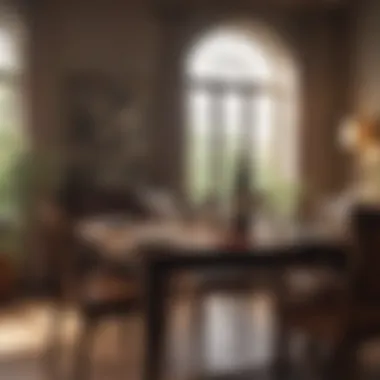

Lastly, professional cleaning services specifically geared toward delicate fabrics provide an elevated level of care and attention. These professionals have targeted training in handling various fabric types, making them integral for effectively addressing wine stains without the risk of harm.
Their unique feature lies in the advanced technology and special products they often have at their disposal. For example, they may utilize low moisture cleaning systems that clean efficiently without excess water exposure. Although hiring such services can be more expensive, the investment often pays off when one weighs the potential costs of fabric damage from improper cleaning.
Prevention of Wine Stains
Preventing wine stains is more than just a mere afterthought—it's a proactive approach that saves time, money, and a fair bit of heartache. For homeowners and party hosts alike, having a strategy to thwart these pesky stains can keep both your surfaces and spirits intact. With red wine being notorious for its staining power, understanding the various ways to prevent spills can make all the difference. Let's delve into the integral aspects of prevention that can lighten your load.
Protective Measures
Stain-Resistant Treatments
Stain-resistant treatments are a prime defense in the battlefield against wine stains. These treatments work by creating a barrier on fabrics and surfaces, making it tougher for the wine to penetrate and set in. The key characteristic of these treatments is their ability to repel liquids, ultimately giving you a fighting chance against unexpected spills. Their popularity stems from the effortless upkeep that comes hand-in-hand with them; once applied, they can significantly reduce maintenance woes in high-risk areas such as dining rooms or living areas.
However, it’s essential to note that not all treatment methods offer the same level of protection. Some might wear off after a few washes or cleanings, while others can be applied via professional services for lasting results. One unique feature to consider is the spectrum of materials these treatments can be used on, ranging from upholstery to carpets. The advantage here is striking a balance between aesthetic appeal and functionality.
Furniture Covers
When it comes to safeguarding your valuable furniture, using furniture covers is an effective method worth considering. Covers can be a lifesaver, acting as a barrier between the furniture and the glass of red or white wine. Their key characteristic is versatility; they can be used on everything from dining chairs to sofas, adapting to whatever arrangement you have. This versatility makes them a practical choice for anyone looking to ward off potential stains without feeling like they’re sitting in a bubble.
Avoiding wine stains becomes easier when you can simply throw a cover over your furniture for special occasions, especially those bustling gatherings when likelihood of spills rises. On the flip side, one disadvantage might be that some covers shift or slip during use, necessitating a check now and again to ensure they’re in place. But with a little diligence, the benefits far outweigh the drawbacks.
Event Planning Tips
Choosing Appropriate Glassware
Choosing the right glassware can have a surprisingly significant impact on preventing wine stains. The specific aspect of glass choice is vital, as wider glasses with a larger mouth can minimize spills and encourage a more controlled pour. Furthermore, light-colored or patterned glassware can help mask minor splashes, making it less likely that a small amount of wine will leave a lasting mark.
This approach becomes a popular choice for hosts aiming to maintain the elegance of their gatherings without worrying incessantly about mishaps. A unique feature of this strategy is how it emphasizes the experience of consuming wine rather than simply combating stains post-factum. However, one must also ponder that too much focus on aesthetics might lead guests to feel uneasy, adding pressure to be overly cautious.
Strategic Seating Arrangements
Strategically arranging seating can be a game-changer during events. By positioning guests deliberately, wine-drinking individuals can be kept away from high-risk areas such as light-colored carpets or delicate furnishings. The unique feature of this tactic is its ability to minimize accidents before they even occur. Thoughtful seating can lead to a more relaxed atmosphere, allowing everyone to enjoy themselves without the stress of potential wine spills looming overhead.
A beneficial choice for hosts, thinking ahead in terms of seating lays the foundation for a worry-free environment. However, it’s important to balance comfort with safety, ensuring that guests aren’t crammed into tight spaces simply to avoid potential stains. The key is establishing a welcoming environment with just enough foresight to prevent the typical mishaps that can mar an otherwise delightful evening.
"An ounce of prevention is worth a pound of cure."
This sentiment rings true when it comes to wine stains and the various methods we can employ to avoid them. Consideration of these preventative measures can save the headache of deep cleaning later on and keep your gatherings joyous.
Dealing with Persistent Stains
Dealing with wine stains that just refuse to budge can feel like a marathon with no finish line. It's one of those nagging problems that can turn a cozy evening into a stressful fiasco. However, understanding how to tackle these persistent stains is crucial for maintaining the integrity and appearance of your surfaces. In this section, we will explore when to seek professional help and delve into long-term care strategies, ensuring you’re well-prepped for any stain emergency.
When to Seek Professional Help
Signs of Permanent Damage
Recognizing when a stain has become a permanent fixture is vital. Permanent damage often manifests in discoloration that no amount of scrubbing can seem to erase. If you notice that the fiber of your fabric feels brittle or looks uneven, it's a glaring sign that the wine has taken its toll. Similarly, with hard surfaces, if you can see cracks or etching that might suggest the wine has penetrated deeply, you might be facing permanent damage.
It's wise to remember that allowing a stain to set can complicate cleanup efforts later on, leading to greater chances that damage might become severe. Once you've established these signs, reaching out to professionals can save you time and additional costs down the road. While household remedies have their place, there's no replacement for expert techniques that can restore your precious surfaces.
Cost Considerations
When it comes to maintaining your belongings, understanding the financial implications of professional help cannot be overlooked. The cost of removing wine stains varies widely based on several factors, such as the type of fiber or surface in need of care and the extent of the damage. For instance, tricky stains on silk upholstery may come with a heftier price tag compared to more durable fabrics. Likewise, elaborate flooring materials might also require specialized treatments. Before committing, take a moment to weigh the potential costs against the benefit of restoring your fabric or surface. This can help determine whether dabbling in DIY efforts before handing it over to the pros makes sense or if it's better to bite the bullet preemptively. Mistakes during initial cleanup attempts can escalate the expense, making understanding these costs all the more critical.
Long-term Care
Regular Maintenance
Implementing a routine maintenance schedule can help prevent wine stains from becoming a pressing issue. Regular cleaning practices will not only prolong the life of your items but also ensure that any resultant stains are dealt with swiftly. For fabrics, brushing them regularly or using a vacuum equipped with an upholstery attachment can keep dust and debris from settling in and making stains worse. With hard surfaces, a periodic gentle scrub and protective sealants can create a barrier against stains before they have a chance to settle in. This proactive approach is not only a safeguarding method but can also reduce the frequency of professional cleaning consultations.
Professional Inspections
Reaching out to professionals for periodic inspections can serve as a safeguard for your investments. Think of this as a routine check-up for your home. These specialists can offer insights into wear-and-tear that may go unnoticed by the untrained eye. They can also provide tailored advice on care specific to your surfaces, which is invaluable in preventing persistent stains from even forming.
In addition, those expert professionals know the best preventative measures specific to different materials. They can advise you when it's the right time to apply treatments or make repairs, which can save you both hassle and money over time. Such insights can prove to be beneficial in prolonging the lifespan of your cherished items as well as ensuring a more stain resistant home environment.
Epilogue
In wrapping up our comprehensive exploration of wine stain removal methods, it’s crucial to recognize the significance of this topic for homeowners, party hosts, and anyone who cherishes their interiors. Wine stains, though seemingly trivial, can leave lasting marks on fabrics and surfaces if not handled promptly and properly. This guide presents you with a toolkit of strategies, from immediate actions to long-term preventive techniques that empower you to tackle spills effectively.
Recap of Key Techniques
Throughout this article, we’ve delved into several methods for addressing wine stains. Here’s a brief recap of the key techniques:
- Immediate Action: The moment a wine stain occurs, the first step should always be to blot, not rub, the area.
- Traditional Methods: Using household staples such as salt and baking soda may seem old-fashioned, but they often prove effective due to their absorbent properties.
- Commercial Solutions: For stubborn stains, consider specialized products designed specifically for wine removal, but always read labels to ensure compatibility with your surface.
- Preventive Measures: Investing in stain-resistant treatments and being mindful during events can drastically reduce the chances of unwanted spills.
By being proactive and informed, you can avoid the headache of wine stains intermingling with your life, not to mention those unforgettable moments that might be marred by a careless splash.
Encouragement for Informed Action
Being equipped with knowledge about wine stain removal is only half the battle; the real work begins when it’s time to put that understanding into practice. Take this information to heart, and remember that every spill doesn't have to turn into a catastrophe. Equip yourself with the right tools and techniques, and don’t let the fear of red wine stop you from enjoying your next gathering.
"A wine stain is merely a momentary setback in the tapestry of life, one that can be removed with a little effort and forethought."
For those occasions where things might go awry, have a plan in place. Whether you are leaning on classic techniques or reaching for advanced cleaning solutions, informed action is the key to maintaining your fabrics and surfaces in pristine condition. Don't hesitate to refer back to this guide when needed, and be confident in your ability to combat potential stains before they do damage!



